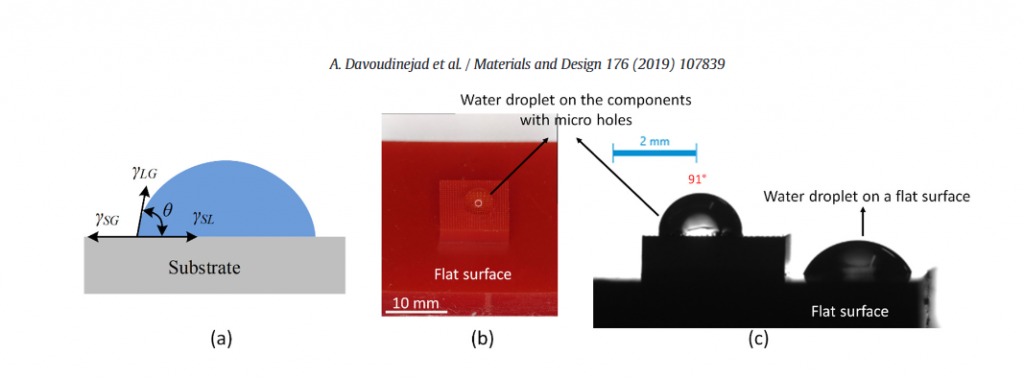Technical University of Denmark: Researchers Assess 3D Printed Micro-Surfaces
 In ‘Fabrication of micro-structured surfaces by additive manufacturing, with simulation of dynamic contact angle,’ researchers explore the uses of 3D printing and additive manufacturing processes in fabricating micro-structured surfaces at the Technical University of Denmark (DTU). Components with micro-holes were 3D printed in a variety of sizes and then evaluated, mainly in terms of surface functionality.
In ‘Fabrication of micro-structured surfaces by additive manufacturing, with simulation of dynamic contact angle,’ researchers explore the uses of 3D printing and additive manufacturing processes in fabricating micro-structured surfaces at the Technical University of Denmark (DTU). Components with micro-holes were 3D printed in a variety of sizes and then evaluated, mainly in terms of surface functionality.
Micro-surfaces have been used with a variety of different components because they have so many high-performance features, plus tolerance, to include resistance against abrasion, corrosion, chemical industry separation, and more. These types of surfaces are also helpful in creating antibacterial areas, plus other surfaces such as those used in robotics and gripper technology. There are challenges in creating micro-surfaces through traditional methods though, along with affordability issues and time required in manufacturing.

(a) Experimental set-up DLP 3D printer (b) The schematic of the DLP technology bottom-up projection 3D printing process. (c) Printed part direction on build plate
Researchers have previously explored water-droplet techniques, and in this study the team used vat photopolymerization to create surfaces for components with micro-holes. They assessed capability of the process and performance of the components with wettability testing. The 3D printer was created and customized at the Technical University of Denmark, with the volume of fluid (VOF) method applied with a ‘series of momentum equations’ and tracking fluid volume. The researchers stated that this study took place at room temperature in an adiabatic process. Three different samples were simulated.
“In general, when the water droplet makes an impact on a solid surface, it starts spreading rapidly in the radial direction on the surface. The height of water droplet decreased continuously until the vertical velocity component reduced to zero, which is called impact stage. Then, the droplet started to recoil due to the surface tension effect of the water droplet, which resulted in the raising of the droplet. With further increase in time, the velocity vector decreased gradually, then the water droplet starts to spread on the substrate,” stated the researchers. “At 200 ms, the water droplet reached an equilibrium state. Specially, the P110 and P150 substrates have significantly larger spreading diameter than the P50 and P70 substrates at 10 ms, due to pinning effect induced by micro hole with Gaussian shaped wall profile is more significant for the sample with small pitch.”
While sample P70 was greater in height, it also displayed ‘the variation of the maximum diameter of a droplet.’ It also showed the smallest amount of maximum diameter, meaning that the droplet spread less—the result also of larger pressure. In measuring all the different surfaces, the contact angle of the water droplet was measured via image processing, showing that the real contact angles were greater than values predicted.

(a) Comparison between the predicted and measured contact angles (b) comparison between the cross-section of the height profile, design P150 and P110 with experimentally printed components with micro holes
“Both simulation and experiments proved that proper microstructures help improve hydrophilic surface (65°) to hydrophobic surface (with a contact angle of 113° in this research),” concluded the research team. “For P70 sample, it has larger air pocket pressure than other samples, which help prevent the spreading and wetting of water droplet on the substrate and help to form larger contact angle.”
“The average value with the experiments was achieved by the model. The applied model represents a promising method to analyze the structures design prior to manufacturing of the parts and to have a better understanding of the behavior of the contact angle on the features.”
Although the focus in this study was on micro surfaces, researchers around the world have delved into creating structures at the micro scale, from microgels to microchips, and processes with micron resolution. What do you think of this news? Let us know your thoughts! Join the discussion of this and other 3D printing topics at 3DPrintBoard.com.

(a) Schematic of contact angle (b) printed sample (c) water drop on the components with micro holes and flat surface (side view)
Subscribe to Our Email Newsletter
Stay up-to-date on all the latest news from the 3D printing industry and receive information and offers from third party vendors.
Print Services
You May Also Like
Low-cost “Suzy” Polymer Powder 3D Printer is Faster and Cheaper than Past Models
Polish laser powder bed fusion (LPBF) firm Sinterit has released a follow-up to its predecessors, Lisa and Nils, called Suzy, a $19,490 printer equipped with a 30W fiber diode laser....
India’s $58M Space Fund Is a Boon for AM Innovation
India’s space industry is picking up serious momentum. With a projected $44 billion space economy by 2033, the country is aggressively expanding its capabilities, fostering private-sector participation, and reducing its...
Japanese Advanced Manufacturing Capabilities Grow in Europe with Sodick’s Purchase of Prima Additive
The global economy is currently undergoing a reshuffling in terms of what gets manufactured where. In large part, this trend is being driven by new geopolitical alliances and the need...
Bosch Invests €6M into Serial Auto Part 3D Printing
German industrial conglomerate Robert Bosch GmbH, the world’s largest supplier of automotive parts, has announced a new investment into Nuremberg, Germany additive manufacturing (AM) facility. The nearly €6 million in...




























